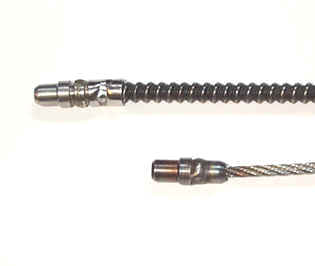Industrial Radiography Sources (ca. 1980s)

Gamma-emitting industrial radiography sources are used to "X-ray" metal that would be too thick for conventional X-rays. They are also used in confined areas that are too small for a portable X-ray machine.
A source typically consists of 30 to 100 curies of Ir-192 or Co-60 that is housed in a small metal capsule (ca. 1 cm long) at one end of a short flexible cable called a "pig tail." (see below). At the other end of the pigtail is a connector that is used to attach the source to a long (25 foot) "crank-out" cable (not shown). The crank-out cable allows the radiographer to operate the source at a safe distance.

The source is positioned on one side of the object (e.g., a weld) being "X-rayed," while photographic film is placed on the other side. Exposure times are very short, e.g., a few seconds.
These types of sources have been responsible for a number of radiation injuries (including deaths). A typical accident scenario involves the pigtail detaching from the crank-out cable and being left behind at the job-site. Later, someone not knowing what it is picks it up and possibly takes it home. Early industrial radiography sources, like those shown above, carried no indication that they were radioactive or dangerous. As such, this type of mistake was all too easy. Pigtails with the old "eye and hook" connectors (lower image) were particularly prone to detaching and being lost.
